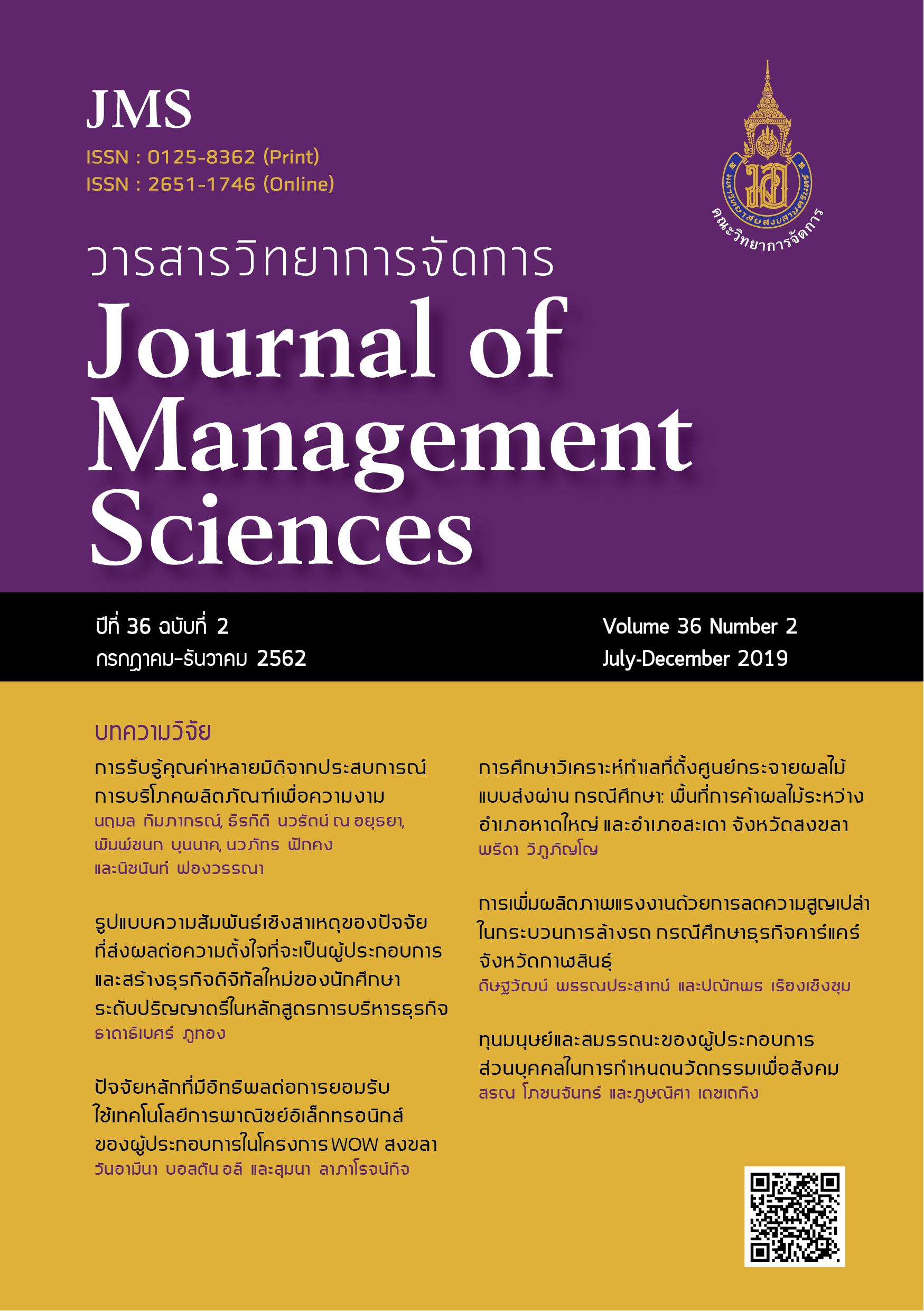การรับรู้คุณค่าหลายมิติจากประสบการณ์การบริโภคผลิตภัณฑ์เพื่อความงาม
Main Article Content
บทคัดย่อ
งานวิจัยนี้มีวัตถุประสงค์เพื่อพัฒนาเครื่องมือวัดการรับรู้คุณค่าจากประสบการณ์การบริโภคผลิตภัณฑ์เพื่อความงาม โดยมีกลุ่มตัวอย่างคือ ลูกค้าที่เคยใช้บริการหรือซื้อและใช้ผลิตภัณฑ์เพื่อความงาม ประเภทเครื่องสำอาง บริการเสริมความงาม และผลิตภัณฑ์เสริมอาหารเพื่อดูแลรูปร่าง จำนวน 695 ราย เครื่องมือที่ใช้ในการวิจัย คือ แบบสอบถามการรับรู้คุณค่าจากประสบการณ์การบริโภคผลิตภัณฑ์เพื่อความงาม รวม 36 ข้อ มีลักษณะเป็นแบบสอบถามปลายปิด โดยใช้มาตรวัดของลิเคิร์ท (Likert Scale) ที่ผู้วิจัยสร้างขึ้นจากการปรับใช้ข้อคำถามที่ได้จากการทบทวนวรรณกรรม (Ittner & Larcker, 1996; Lai et al., 2009; Hellier et al., 2003; Sweeny & Souter, 2001; Woodruff, 1997; Bolton & Drew, 1991; Sheth, Newman, & Gross, 1991; Zeithaml, 1988) และจากการสัมภาษณ์เชิงลึกผู้ซื้อผลิตภัณฑ์เพื่อความงาม และผู้ใช้บริการด้านความงาม จำนวน 30 ราย เพื่อเข้าใจถึงบริบทของประสบการณ์ที่ได้รับ ผลการวิเคราะห์คุณภาพรายข้อด้วยการหาค่าสหสัมพันธ์ระหว่างข้อคำถามแต่ละข้อกับคะแนนรวมที่ปรับแก้แล้ว และค่าสถิติแบบเป็นอิสระจากกัน วิเคราะห์ความตรงเชิงภาวะสันนิษฐาน ด้วยวิธีการการวิเคราะห์องค์ประกอบเชิงสำรวจ ได้ข้อคำถาม 20 ข้อคำถาม ประกอบด้วย 5 องค์ประกอบหลัก คือ การรับรู้คุณค่าด้านการใช้งาน คุณค่าด้านสังคม คุณค่าด้านอารมณ์ มีมากกว่ามิติคุณค่าด้านความรู้ความคิด คุณค่าที่มีเงื่อนไข และสรุปได้ว่าการรับรู้คุณค่าจากประสบการณ์การบริโภคผลิตภัณฑ์เพื่อความงามในมิติด้านคุณค่าด้านการใช้งาน คุณค่าด้านสังคม คุณค่าด้านอารมณ์ มีน้ำหนักในการรับรู้คุณค่าจากประสบการณ์การบริโภคผลิตภัณฑ์เพื่อความงามมากกว่ามิติคุณค่าด้านความรู้ความคิด คุณค่าที่มีเงื่อนไข ผลการวิจัยที่พบสามารถนำไปใช้ในการกำหนดกลยุทธ์การตลาดเพื่อจูงใจผู้บริโภคกลุ่มเป้าหมาย อีกทั้งยังช่วยในการเสริมสร้างความแข็งแกร่งของตราผลิตภัณฑ์ของผลิตภัณฑ์เพื่อความงามได้อย่างมีประสิทธิภาพมากขึ้น
Article Details

อนุญาตภายใต้เงื่อนไข Creative Commons Attribution-NonCommercial-NoDerivatives 4.0 International License.
บทความที่ตีพิมพ์ถือเป็นลิขสิทธิ์ของวารสารวิทยาการจัดการ มหาวิทยาลัยสงขลานครินทร์ อย่างไรก็ตาม กองบรรณาธิการไม่สงวนลิขสิทธิ์ในการทำซ้ำ คัดลอก หรือเผยแพร่ แต่จะต้องอ้างอิงให้ถูกต้องตามหลักวิชาการ
เอกสารอ้างอิง
Bollen, K.A. (1989). Structural Equations with Latent Variables. John Wiley and Sons, Inc., New York.
Dodds W. B. & Monroe, K. B. (1985). The effect of brand and price information on subjective product evaluations. In E. C. Hirschman & M. B. Holbrook (Eds.), Advances in consumer research (pp. 85–90). Provo, UT: Association for Consumer Research.
Economies News. (2018). 10 percent growth per year & market value near 280 Billion. Neawna Newspaper. Retrieved from https://www.ryt9.com/s/nnd/2818005.
Faryabi, M. R., Kaviani, F. E., Yasrebdoost, H., & Dept, E. (2012). The relationship between Customer Perceived Value and Customers Satisfaction The Banking Industry in Iran. Australian Journal of Basic and Applied Sciences, 6(12), 76-85.
Frow, P. & Payne, A. (2007). Towards the Perfect customer experience. Brand Management. 15(2) 2, 89-101.
Gentile, C., Spiller, N., & Noci, G. (2007). How to sustain the customer experience: an overview of experience components that co-create value with the customer. European Management Journal. 25(5), 395-410.
Gilmore, J. H. & Pine, B. J. (1997). Beyond goods and services: Staging experiences and guiding transformations. Strategy and Leadership. 25(3), 11-17.
Hair, J. F., Black, W. C., Bain, B. J., Anderson, R. E., & Tatham, R. L. (2006). Multivariate Data Analysis (Sixth Edition). Upper Saddle River, NJ: Pearson Education International.
Hallowell, R. (2000). Sothebys.com, HBS Case No. 9-800-387, Harvard Business School Publishing, Boston, MA.
Helkkula, A. (2011). Characterising the concept of service experience. Journal of Service Management. 22(3), 367-389.
Hellier, P. K., Geursen, G. M., Carr, R. A., & Rickard, J. A. (2003). Customer Repurchase Intention: A General Structural Equation Model. European Journal of Marketing, 37, 1762-1800.
Hirschman, E. C. & Holbrook, M. B. (1982). Hedonic consumption: emerging concepts, methods and Propositions. Journal of Marketing. 46(3), 92-101.
Holbrook, M. B. (1994). The nature of customer value, an axilogy of services in the consumption experience. Thousand Oaks, CA: Sage.
Holbrook, M. B. (1999). Consumer value: A framework for analysis and research. New York, NY: Psychology Press.
Holbrook, M. B. & Hirschman, E. C. (1982). The Experiential Aspects of Consumption: Consumer Fantasies, Feeling, and Fun. Journal of Consumer Research. 9(2), 132-140.
Holmes, G. R. & Paswan, A. (2012). Consumer reaction to new package design. Journal of Product and Brand Management. 21(2), 109-116.
Homburg, C., Schwemmle, M., & Kuehnl, C. (2015). New product design: concept, measurement, and consequences. Journal of Marketing. 79(3), 41-56.
Ittner, C. D. & Larcker, D. F., (1996). Measuring the impact of quality initiatives on firm financial performance. In: Fedor, D. F., Ghosh, S. (Eds.), Advances in Management of Organization Quality, Vol. 1. JAI Press, Greenwich, CT, pp. 1-37.
Janawade, V., Bertrand, D., Léo, P. Y., & Philippe, J. (2015). Assessing ‘meta-services’: customer's perceived value and behaviour. The Service Industries Journal, 35(5), 275-295.
Jin, N., Lee, S., & Lee, H. (2015). The effect of experience quality on perceived value, satisfaction, image and behavioral intention of water park patrons: New versus repeat visitors. International Journal of Tourism Research, 17(1), 82-95.
Klaus, P. & Maklan, S. (2012) EXQ: a multiple-item scale for assessing service experience, Journal of Service Management. 23(1), 5-33.
Klaus, P. & Maklan, S. (2013). Towards a better measure of customer experience. International Journal of Market Research. 55(2), 227-246.
Maklan, S. & Klaus, P. (2011) Customer experience: are we measuring the right things? International Journal of Market Research. 53(6), 771-792.
Lai, F., Griffin, M., & Babin, B. J. (2009). How quality, value, image, and satisfaction create loyalty at a Chinese telecom. Journal of Business Research, 62(10), 980-986.
Monroe, K. B. & Chapman, J. D. (1987). Framing effects on buyers’ subjective product evaluations. Advances in Consumer Research, 14, 193–197.
Otto, J. E. & Ritchie, J. R. B. (1996). The Service experience in tourism. Tourism Management. 17(3), 165-174.
Patterson, P. G., & Spreng, R. A. (1997). Modelling the Relationship between Perceived Value, Satisfaction and Repurchase Intentions in a Business-to-Business, Services Context: An Empirical Examination. International Journal of Service Industry Management, 8(5), 414–434.
Pine, B. J. & Gilmore, J. H. (1998). Welcome to the experience economy. Harvard Business Review. 76(4), 97-105.
Schmitt, B. (1999). Experiential marketing. Journal of Marketing Management, 15(1-3), 53-67.
Sheth, J. N., Newman, B. I., & Gross, B. L. (1991). Why we buy what we buy: A theory of consumption values. Journal of Business Research, 22(2), 159-170.
Slater, S. F., & Narver, J. C. (2000). The positive effect of a market orientation on business profitability: a balanced replication. Journal of Business Research, 48(1), 69-73.
Sweeney, J. C., & Soutar, G. N. 2001. Consumer perceived value: The development of a multiple item scale. Journal of retailing, 77(2), 203-220.
Thaler, R. H. (1985). Mental accounting and consumer choice. Marketing Science, 4(3), 199-214.
Verleye, K. (2015). The co-creation experience from the customer perspective: its measurement and Determinants. Journal of Service Management. 26(2), 321-342.
Voss, G. B., Parasuraman, A., & Grewal, D. (1998). The roles of price, performance, and expectations in determining satisfaction in service exchanges. Journal of marketing, 62(4), 46-61.
Zeithaml, V. A. (1988). Consumer Perceptions of Price, Quality, and Value: A Means-End Model and Synthesis of Evidence. The Journal of Marketing, 52(3), 2-22.

